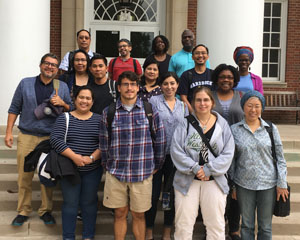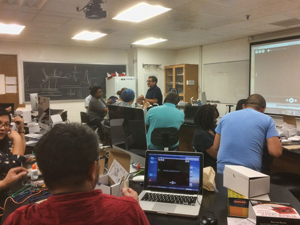UMD Hosted Neuroscience Workshop for Local High School Teachers
Workshop taught basic neuroscience concepts and demonstrated hands-on experiments for local high school teachers
The University of Maryland hosted 14 high school teachers at a neuroscience outreach workshop on Saturday, September 16, 2017. UMD Associate Professor of Biology Ricardo Araneda ran the workshop with Rhonda Dzakpasu, an associate professor of physics at Georgetown University.
 Participants learned how to conduct basic neuroscience experiments, which they can now perform in their own classrooms. Using the “Muscle SpikerBox Bundle” and the “Neuron SpikerBox Bundle” kits from Backyard Brains, Araneda taught participants to measure and visualize firing neurons from their own muscles and from cockroaches. Dzakpasu introduced participants to Neurons in Action, a software package of neuroscience tutorials, animations and simulations. Two members of Araneda’s laboratory, biological sciences graduate student Pablo Villar del Rio and neuroscience and cognitive science graduate student Ruilong Hu, offered one-on-one help while participants learned how to record neural activity.
Participants learned how to conduct basic neuroscience experiments, which they can now perform in their own classrooms. Using the “Muscle SpikerBox Bundle” and the “Neuron SpikerBox Bundle” kits from Backyard Brains, Araneda taught participants to measure and visualize firing neurons from their own muscles and from cockroaches. Dzakpasu introduced participants to Neurons in Action, a software package of neuroscience tutorials, animations and simulations. Two members of Araneda’s laboratory, biological sciences graduate student Pablo Villar del Rio and neuroscience and cognitive science graduate student Ruilong Hu, offered one-on-one help while participants learned how to record neural activity.
The workshop participants teach at eight public high schools in Montgomery and Prince George’s counties in Maryland. They were recruited through Terrapin Teachers, a UMD program that aims to increase the number of highly skilled science and math teachers and is a partnership between the university’s College of Computer, Mathematical, and Natural Sciences and College of Education.
 A grant from the Grass Foundation awarded to Araneda and Dzakpasu in fall 2016 funded the workshop as part of the foundation’s mission to support research and education in neuroscience. Araneda, whose laboratory researches how chemical signals affect olfactory system circuits, olfactory processing and olfactory behavior, wanted to run the workshop because of his longstanding interest in educational outreach.
A grant from the Grass Foundation awarded to Araneda and Dzakpasu in fall 2016 funded the workshop as part of the foundation’s mission to support research and education in neuroscience. Araneda, whose laboratory researches how chemical signals affect olfactory system circuits, olfactory processing and olfactory behavior, wanted to run the workshop because of his longstanding interest in educational outreach.
“I truly believe that improving the quality of science education starts at the high school level, especially in communities that have fewer resources,” said Araneda, who is also director of the physiological systems concentration in the Biological Sciences Graduate Program at UMD. “For the past six or seven years, my laboratory has opened a spot for a high school student every semester. I’m extremely happy that through these funds, we were able to reach high school teachers who will hopefully teach their own students how to do experiments in neuroscience.”
Araneda offered to help the participants implement the kits and software from the workshop, and he hopes to hold the workshop again if he can obtain the necessary funding.
“If I could, I would do this every year,” Araneda said.
###
Media Relations Contact: Irene Ying, 301-405-5204, zying@umd.edu
University of Maryland
College of Computer, Mathematical, and Natural Sciences
2300 Symons Hall
College Park, MD 20742
www.cmns.umd.edu
@UMDscience
About the College of Computer, Mathematical, and Natural Sciences
The College of Computer, Mathematical, and Natural Sciences at the University of Maryland educates more than 7,000 future scientific leaders in its undergraduate and graduate programs each year. The college’s 10 departments and more than a dozen interdisciplinary research centers foster scientific discovery with annual sponsored research funding exceeding $150 million.







